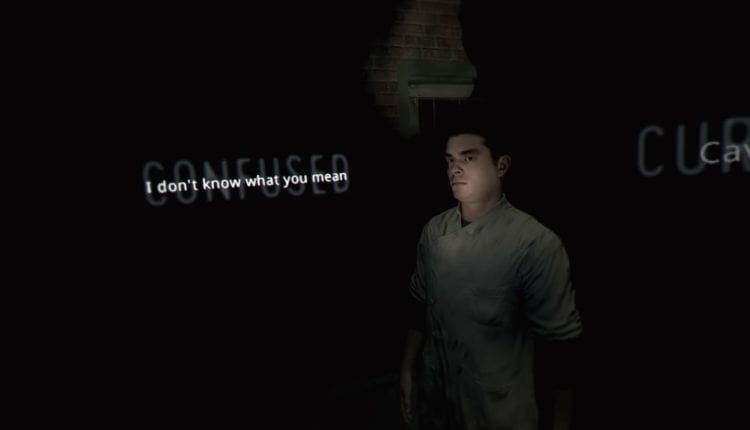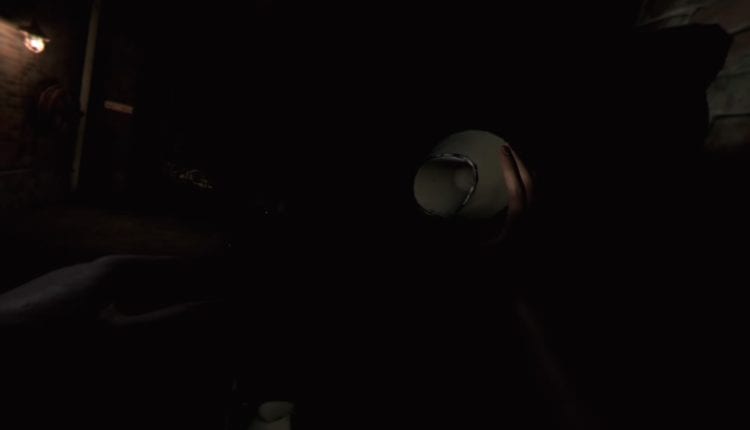WELCOME TO BLACKWOOD
Supermassive’s languidly paced PSVR exclusive horror game, The Inpatient, drops you into the shoes (more like filthy bare feet) of a new admission to the Blackwood Sanatorium sometime in the 1950s, 60 years before the youngsters of Until Dawn will brave the mental asylum’s dilapidated secrets. As the game begins, it’s tempting to use the provided sliders to craft the on screen avatar in your image. The game practically begs you to do it this way, pushing for bland representation over narrative cohesiveness. Presumably, this is to increase the sense that the titular Inpatient is you and not, for instance, some other schmuck with a joypad.
This is the highly sought after, seldom achieved “full immersion” that PSVR scholars are always crowing about. Really, it’s the zenith, or as the kids say, the final form of it (at least until we have full body, free floating haptic feedback or something). That’s because if your avatar’s undulating spaghetti arms are the same color as yours, move in janky 1:1 ratio with your own, and the landscape of your in-game bust appears in line with the gender you most identify with, well then it must be you. That means that all the decisions you make in the game, which features the same butterfly cause and effect as Until Dawn, are based upon who you are as a person.
Which would be great if:
- I wanted to be me
- I wanted to be me in this shoddy retread of a story
- I wanted to be me in this shoddy retread of a story and didn’t instead feel like Frankenstein’s monster shambling for a late night glass of milk in a spooky house.
- The Inpatient hadn’t come up woefully short of full immersion
After about 20 minutes of playtime it becomes abundantly clear that the technological limitations of the current PSVR headset and input methods allowed by the prehistoric Move controllers are going to rear their ugly head. The actors are too wooden, the sets are plain and underdressed, the move controls are counter intuitive (often leaving your head turned one way while you’re body crab walks in another), the load times between sections are long black screens and despite some beefy graphics and moody atmosphere. It all seems very cheap. Even the jump scares are of the hoariest variety. Though, if you’re reading this like a review, know that the first few nearly had my skeleton jumping out of my skin.
So, instead of trying to pretend that you’re this character that looks like you and that all this is really happening to you like the game seems to want… might I suggest a different approach? Treat this experience like the evolution of a schlocky B movie.
Treat it like it’s that direct to video horror movie you saw a copy of in the bargain bin at Best Buy with a former children’s television actress gracing its terrible cover art and you’re its star… in a bad wig.

WHAT’S MY MOTIVATION?
It sounds delusional but listen carefully.
Approaching The Inpatient as if you’re an actor doing scenes on a set transforms nearly all of its faults into stealth positives. Remember those wooden actors? They’re the director’s friends and co-workers! It’s up to you as the B-list star to carry the film with these virtual broomsticks. The load times? That’s the part where the director yells cut and you go have a smoke before your next scene! The voices you hear in the inky tar blackness are the ghosts of nicotine, the whispering killer. The languid pace and janky move controls? It’s not about “being in the action.” It’s about hitting your mark and saying your doofy lines! That’s why these soulless automatons just wait for you to come over and click on them. They’re probably sneaking a last peek at a crumpled up page from the script while waiting for you to finish awkwardly flipping over a prop clipboard in your hands.
During my brief stint at James Franco’s School for Hard Knocking (may or may not be a real institution,) I learned that you act “from the feet up.” Not just literally when you’re simulating acrobatic sex acts but when you’re attempting to find a character. Putting on a different pair of shoes can help figure out who this person you’re playing is by defining the way they stand, walk, and comport themselves. A pair of oversized clown shoes, for example, makes your steps floppy, attention grabbing and sad. It goes beyond the feet and extends to all aspects of your character. For instance, how they hold a book or what kind of glasses they wear. If your character shambles with limbs jutting out all akimbo, use it. Details like that tell you who you are and they are plentiful in this game.
None of this would work, of course, without The Inpatient’s revelatory new mechanic which allows the player to choose between their lines by speaking them out loud. These choices are even presented with director cues for how to read them. Your motivation, so to speak. When a character confronts the player about how they got there, two dialogue options open up with the third being stony silence. In one instance you can choose to answer with confusion like, “I don’t know what you mean?” In another, curiosity like, “What do you mean?” Nothing you say is particularly interesting or profound. This isn’t an award winning script. It’s all about how you say these lines that adds the drama. For me this was a total game changer because not only did it help me craft my character separate from myself, but it gave me carte blanche to ham it up and chew the scenery like Alan Rickman as the Sheriff of Nottingham in Robin Hood: Prince of Thieves whose exaggerated death scene lasts so long I think it might still be going on. Incidentally, it also excuses the lack of real, interesting consequences that result from those choices.
Smily winky face.

ALL THE WORLD IS A STAGE
The not-so-dirty secret of The Inpatient is that there’s not a whole lot to actually do at any given moment. The first hour or so is spent mostly in a locked room with a few midnight sojourns through a dream corridor punctuated by a freaky 80s laser light show to break it up. There’s always a glowing hot spot winking and nudging you to push things forward but aside from those, there’s really only a few props scattered about that the player can interact with; a faucet, a light, a cup, a bottle of pills. That’s where my approach enhances the experience.
For me, being locked in that room was all about selling my character’s mental state to the audience. When a cockroach crawls across the table I did what I thought was expected and smashed it with the book I was holding. Then I smashed it again, and again, and then again. I started to feel that maybe my smashing of the pest had become disturbing. My hands were jittering, my body lurched and swung wildly about but with the measured pace of a stone cold killer. Who was I? Was I simply reeling from the drugs that were administered to me at the beginning of the narrative or was my mind truly severed from my physical presence. I never felt claustrophobic but, in an attempt to open the door or summon a guard, I beat my cup against the bars while quietly chanting “Attica!” Every time I did, the bars made a satisfying clang, and my controller reacted as if I’d hit something solid. Again, you could not do that. You could rush from one glowy hot spot to the next and finish the whole experience in a couple hours but I’m telling you, there’s a better way.
Things really came together for me when I got a roommate. Having someone to work off of, to play emotions off of, gave me that final push to determining just how much of a snarky asshat my Inpatient was. Even the way I sloppily devoured the ominous sandwich a nurse would periodically deliver to me became a kind of show of deranged dominance meant to communicate that “this is my cell, you’re a guest here.” Later when I ran into a guy outside my cellblock I made sure to carry a butter knife with me and keep my eye (and flashlight) trained on him. My momma taught me never to trust someone who insists you go first. Even if he is just being a perfect gentleman…

HOW AM I NOT MYSELF?
Did I not mention that I chose to play as a beautiful olive skinned woman?
I could’ve played as yet another white guy like; Booker, Kratos, Joel, Cole, Nathan, Alan, Steve, Duncan, You’re Not Even Checking The Names At This Point Because You Know They’re All Probably Real. That would’ve been closest to how I look in real life but it also would’ve been boring. Why not take advantage of the virtual in VR and see the world from a perspective different from my own? The Inpatient changes things up depending on which gender or ethnicity you choose to play as gender swapping characters and changing their behavior and attitudes toward you.
As a woman, recently drugged and completely vulnerable, the clean cut orderly who moved me from the examination room to my cell gave me total creeper vibes. Beneath his sanitized “aww shucks ma’am” All American boy veneer, I could sense a sinister undercurrent. I could tell just by the way he was hitting on me that he liked to tear the wings off butterflies. Of course, I shut down his inappropriate flirting almost immediately and suffered his inattention as a result. If I had made different acting choices, if I’d thought my character more sly, or less drug addled by her earlier run-in with a hypodermic needle, I might’ve attempted to curry his favor by flirting back.
Nope. No way. I was not gonna encourage this horny serial killer in training. I’d have to make it on my own and hope he was turned off enough by my cool demeanor to stay the hell away.
Situations like the one above and the way I reacted to them really illustrate my point. When this guy hit on me at my most helpless, I had to consider not only who my character was, but what their experiences had taught them and what they could do in response. When I made the decision to shut his advances down with withering sarcasm and disinterest, I did so knowing that I was burning a bridge with a potentially useful ally but my gut told me this was for the best.

YOU’RE LIVING IN A FANTASY WORLD
No matter whether you choose to play as a character similar to yourself or the polar opposite, whether you say your lines or simply select them with the controller, one thing is certain, The Inpatient is not very good. It’s short. It’s uneventful. It controls poorly. It offers very little in the way of gameplay. It’s slow and it’s not very scary. If you dropped close to $40 bucks on it at launch, as I did, then you understand why I’ve bent over backwards to make it work. What I’ve provided above is a kind of fantasy world coping mechanism where I and all my sucker brothers and sisters did not spend our hard earned money on a rushed, poorly executed and badly conceived VR tie-in to a popular franchise but instead on a B horror movie simulator. One which isn’t broken because it’s supposed to be that way. That’s its charm.
I envy those of you who will pick up this title on a lark during the next big sale, because approaching the game in the way I’ve written exhaustively about above, actually does make it more fun. Stepping outside of yourself and fully embodying a character, using little gameplay moments of your own design to help shape them, could be a new style of game that mixes acting with interactive storytelling. This isn’t it, but it could be! Sure, you need some imagination and a healthy dose of delusion but maybe that’s where VR breaks from traditional gaming? Maybe the onus is upon us to make our own fun and our own drama when developers provide us with the sets, the actors, and the props but not much in the way of a compelling reason to slog forward through the empty halls.
Even as the end credits roll (a few short hours after the opening credits began,) the game makers double down on the notion of you being the star, listing the main character as “The Inpatient” and the actor portraying them as you. So go be the star but, trust me, resist the urge to just be you. Try being a crazy, asshole. Way more fun.

